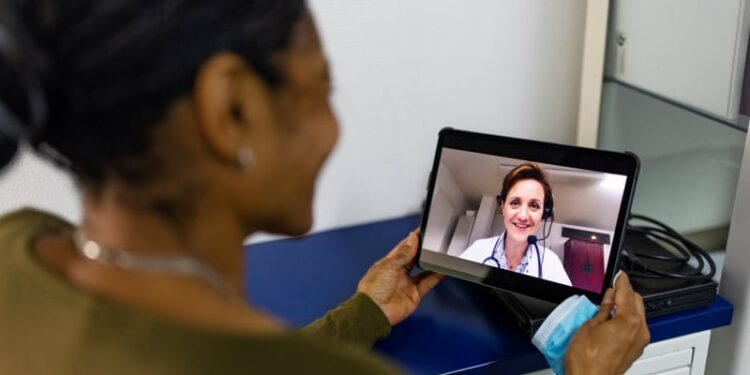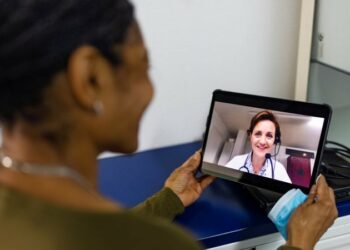A virtual visit with one’s own primary care physician (PCP) is less likely to result in a subsequent emergency department (ED) visit compared with a visit with an outside physician, research suggested.
A cohort study of more than 5 million Ontario residents with a PCP found that those who had a virtual visit with a physician other than their own were 66% more likely to visit the ED within 7 days.
“Because our study relied on health administrative data only, we cannot know for sure how necessary each ED visit was,” lead author Lauren Lapointe-Shaw, MD, PhD, assistant professor of medicine at the University of Toronto, told Medscape Medical News. “We did note, however, that the association between the type of virtual visit and ED use was stronger for low-acuity ED visits — those that are most likely to have been avoided with timely access to a PCP familiar with the patient.”
The study was published online on December 27, 2023, in JAMA Network Open.
Existing Relationship Beneficial
To investigate potential differences in subsequent ED use between patients who had a virtual visit with their own PCP and patients who had a virtual visit with an outside physician, the researchers conducted a propensity score–matched cohort study among all Ontario residents with a PCP who had a virtual PCP visit from April 2021 through March 2022. In a secondary analysis, visits with one’s own physician were compared with visits with a physician working in direct-to-consumer telemedicine. The primary outcome was an ED visit within 7 days after the virtual visit.
Among 5,229,240 patients, 79.8% (mean age, 49.3 years; 58% women) had a virtual visit with their own physician, and 20.2% (mean age, 41.8 years; 57.4% women) had a virtual visit with an outside physician.
In the matched cohort of 1,885,966 patients, those who saw an outside physician were 66% more likely to visit an ED within 7 days than those who had a virtual visit with their own physician (3.3% vs 2.0%). This corresponds to one additional ED visit for every 77 virtual visits with an outside physician. The increased risk was greater for low-acuity patients (0.8% vs 0.4%; relative risk [RR], 1.90) than for high-acuity patients (0.7% vs 0.5%; RR, 1.46).
Increased use of the ED associated with low-continuity virtual visits was front-loaded in the first few days. Therefore, the authors suggested that virtual visits may serve a triaging function, enabling the identification of patients who would benefit from an in-person assessment.
Patients who had an outside-physician virtual visit also were more likely than those with an own-physician visit to have an in-person PCP visit within 7 days of the virtual visit (6.1% vs 4.9%; RR, 1.25), but that visit was less likely to be with their own physician (1.1% vs 4.2%; RR, 0.25).
Similarly, they were nearly twice as likely to have a repeat virtual visit within 7 days (8.9% vs 4.7%; RR, 1.88), but again, the visit was less likely to be with their own physician (2.1% vs 4.2%; RR, 0.50).
A subgroup analysis showed that the increased risk for a 7-day ED visit associated with an outside-physician virtual visit was greater for younger age groups. Children and adolescents were at the highest risk (RR, 1.96), followed by adults aged 18-64 years (RR, 1.69) and those aged 65 years or older (RR, 1.40).
Furthermore, the increased risk for ED visits was greater when comparing patients with direct-to-consumer telemedicine visits with patients with own-physician visits (RR, 2.99). As in the main cohort, the increased risk was front-loaded in the first 2 days.
“Our findings add to a growing body of evidence suggesting that virtual care is most efficient when used within an existing therapeutic relationship,” said Lapointe-Shaw. The team currently is studying patient outcomes of physicians who provide walk-in clinic care.
Insurance Coverage Questions
Asif Ansari, MD, regional medical director at Montefiore Medical Group in New York, told Medscape Medical News that his experience as a PCP “has led to the conclusion that care delivered by a patient’s own provider is superior, whether in person or via telemedicine. Nothing can replace that relationship, level of familiarity, and access to personal health information.” Ansari was not involved in the study.
The study did not include virtual visits with another physician in the same clinical group, he noted. A physician in the same group “likely operates on the same electronic health record, which contains valuable information including medical problem lists, lab results, medication lists, and allergies. Theoretically, access to such information would lower ED utilization. This is a significant missing piece when we look at the overall impact of virtual care.”
More patients are now looking for the convenience and access that virtual medicine provides, noted Ansari. “If we do not appropriately leverage this tool in primary care, we will see more and more external entities enter the field, leading to further care fragmentation.”
“The rate-limiting step may be what the insurers cover as they review future trends in utilization and quality metrics,” he added. “It is important [for us] as clinicians to thoughtfully engage and help determine where the future leads us in the interest of our patients.”
Steven Shook, MD, lead for virtual health at Cleveland Clinic in Ohio, also commented on the study for Medscape Medical News. He noted that without additional information, “it’s hard to say that the two groups they’re comparing are identical. For example, patients who are self-selecting to do virtual visits with an outside physician or direct-to-consumer telemedicine may have good reasons — maybe they can’t see their own doctor in the hours available, or maybe their own doctor doesn’t do virtual visits. We don’t know the urgency of the need to see a doctor. So, lots of factors aren’t included or measured in this study.”
Future studies need to assess how virtual visits affect the total cost of care, Shook added. “It’s not just whether the patients end up in the ED, but whether we may be more likely to order an MRI because we can’t lay hands on the patient. And we need to know how the need for any additional tests affects the patient’s diagnosis and outcome.”
Overall, Shook said, “virtual visits need to be integrated into patient care. They need to be part of a comprehensive program that primary care practices provide to a patient, to balance the access, convenience, and continuity that comes with that.”
The study was supported by ICES, which is funded by an annual grant from the Ontario Ministry of Health (MOH) and the Ministry of Long-Term Care. The study also received funding from the MOH through a grant awarded to Lapointe-Shaw and a project grant from the Canadian Institutes of Health Research awarded to Lapointe-Shaw and another coauthor. Lapointe-Shaw, Ansari, and Shook reported no conflicts of interest.
Source link : https://www.medscape.com/viewarticle/virtual-visits-ones-own-pcp-tied-fewer-ed-visits-2024a100008p?src=rss
Author :
Publish date : 2024-01-04 07:09:42
Copyright for syndicated content belongs to the linked Source.















